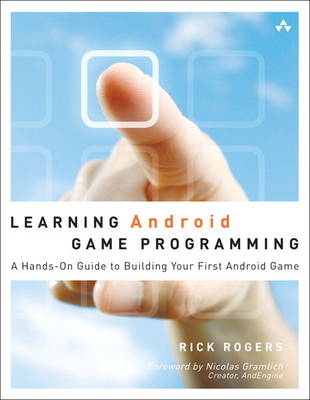
Learning Android Game Programming
Addison-Wesley Educational Publishers Inc (Verlag)
978-0-321-76962-6 (ISBN)
- Titel ist leider vergriffen;
keine Neuauflage - Artikel merken
Learning Android Game Programming is your hands-on, start-to-finish guide to creating winning games for today’s rapidly growing Android mobile device marketplace. If you have even basic Android development experience, Rick Rogers will help you build on your knowledge to quickly create low-budget 2D mobile games that sell.
The book starts with an up-to-the-minute overview of today’s Android mobile games marketplace, reviews each leading genre, and teaches you the foundational concepts of game development. You’ll design a simple game, then master every step of game development with AndEngine—the powerful, open source, free game-development engine. Every chapter teaches with sample code you can actually use, including many examples drawn from the published game, Virgins Versus Vampires (V3).
With this book you’ll learn how to
Use free Android tools for creating code, artwork, and sound
Implement the “game loop” that is at the heart of Android games
Bring your game to life with scene transitions and entity modifiers
Make the most of bitmap and vector graphics, sprites, and animation
Integrate user input via touch, multitouch, keyboard, voice recognition, accelerometer, location, and compass
Build infinite virtual worlds with tile maps
Create, save, and reuse powerful particle effects
Find, acquire, modify, and use background music and sound effects
Implement highly realistic physics effects with Box2D
Use AI techniques to make your games smarter and more fun
Build a scoring framework based on collisions between your game elements
Download the free version of Virgins Versus Vampires (V3) from Android Market today, as you learn how to build the game in this book
Rick Rogers has been developing software for more than thirty years and has been focused on software for mobile devices for the last twelve years. He is the author of numerous technical magazine articles and a previous book on introductory Android application development. He has developed mobile device software for large and small companies, and participated in international consortia that have shaped the evolution of mobile devices.
Foreword xix
Preface xxi
Acknowledgments xxiii
About the Author xxv
Chapter 1: Mobile Games 1
The Mobile Game Market 1
The World of Computer Games 2
AndEngine Examples 10
Summary 12
Exercises 12
Chapter 2: Game Elements and Tools 15
Software Development Tools 15
Graphics Tools 20
Audio Tools 24
Getting Our Feet Wet: The Splash Screen 26
Summary 31
Exercises 32
Chapter 3: The Game Loop and Menus 33
Game Loops in General 33
The Game Loop in AndEngine 34
Adding a Menu Screen to V3 37
Memory Usage 50
The Quit Option 51
Summary 51
Exercises 52
Chapter 4: Scenes, Layers, Transitions, and Modifiers 53
Scenes in AndEngine 53
Creating the Game Level 1 Scene 79
Summary 85
Exercises 85
Chapter 5: Drawing and Sprites 87
Quick Look Back at Entity 87
Drawing Lines and Rectangles 88
Sprites 89
Summary 106
Exercises 107
Chapter 6: Animation 109
Requirements for Animation 109
Animation Tiled Textures 110
Animation in AndEngine 111
Animation Example 113
Adding Animation to Level1Activity 118
Animation Problems 126
Advanced Topic: 2D Animations from 3D Models 127
Summary 127
Exercises 128
Chapter 7: Text 129
Fonts and Typefaces 129
Loading Fonts 130
Text in AndEngine 133
Custom Fonts 137
Adding Custom Fonts to V3 139
Summary 146
Exercises 146
Chapter 8: User Input 149
Android and AndEngine Input Methods 149
Adding User Input to V3 167
Summary 171
Exercises 172
Chapter 9: Tile Maps 173
Why Tile Maps? 173
Types of Tile Maps 173
Structure of Tile Maps 176
Tile Maps in AndEngine 176
The Tile Editor: Tiled 179
TMX Files 180
Orthogonal Game: Whack-A-Vampire 181
Isometric Tile Maps 196
Summary 197
Exercises 197
Chapter 10: Particle Systems 199
What Is a Particle Emitter? 200
How Do Particle Systems Work? 200
The AndEngine Particle System 201
Creating Particle Systems 206
Particle Emitters in V3 211
Summary 216
Exercises 217
Chapter 11: Sound 219
How Sound Is Used in Games 219
Sources of Music and Effects 220
Tools for Music and Effects 221
Sound Codec Considerations 221
Sound in AndEngine 222
Adding Sound to V3 225
Summary 241
Exercises 241
Chapter 12: Physics 243
Box2D Physics Engine 244
Building Levels for Physics Games 246
AndEngine and Box2D 248
Irate Villagers: A Physics Gamelet for V3 261
Implementing IV 261
Summary 276
Exercises 277
Chapter 13: Artificial Intelligence 279
Game AI Topics 279
Implementing AI in V3 287
Summary 297
Exercises 297
Chapter 14: Scoring and Collisions 299
Scoring Design 300
Collisions in AndEngine 306
Letting the Player Score 308
Graveyard (Level 1) 308
Whack-A-Vampire 315
Irate Villagers 318
Summary 322
Exercises 322
Chapter 15: Multimedia Extensions 325
Downloading Extensions 325
Live Wallpapers 326
MOD Music 332
Multiplayer Games 336
Multi-Touch in AndEngine 337
Augmented Reality 339
Summary 343
Exercises 344
Chapter 16: Game Integration 347
Difficulty Balancing 348
Completion 350
Level 1: The Main Game 352
Whack-A-Vampire 358
Irate Villagers 360
Options Menu 363
Summary 363
Exercises 363
Chapter 17: Testing and Publishing 365
Application Business Models 365
Testing and Getting Ready 366
Publishing 373
Promoting Your Game 376
Summary 380
Appendix: Exercise Solutions 381
Index 429
| Erscheint lt. Verlag | 12.12.2011 |
|---|---|
| Verlagsort | New Jersey |
| Sprache | englisch |
| Maße | 177 x 226 mm |
| Gewicht | 728 g |
| Themenwelt | Kinder- / Jugendbuch ► Sachbücher |
| Mathematik / Informatik ► Informatik ► Netzwerke | |
| Informatik ► Software Entwicklung ► Spieleprogrammierung | |
| Informatik ► Weitere Themen ► Computerspiele | |
| Technik ► Nachrichtentechnik | |
| ISBN-10 | 0-321-76962-7 / 0321769627 |
| ISBN-13 | 978-0-321-76962-6 / 9780321769626 |
| Zustand | Neuware |
| Haben Sie eine Frage zum Produkt? |
aus dem Bereich


